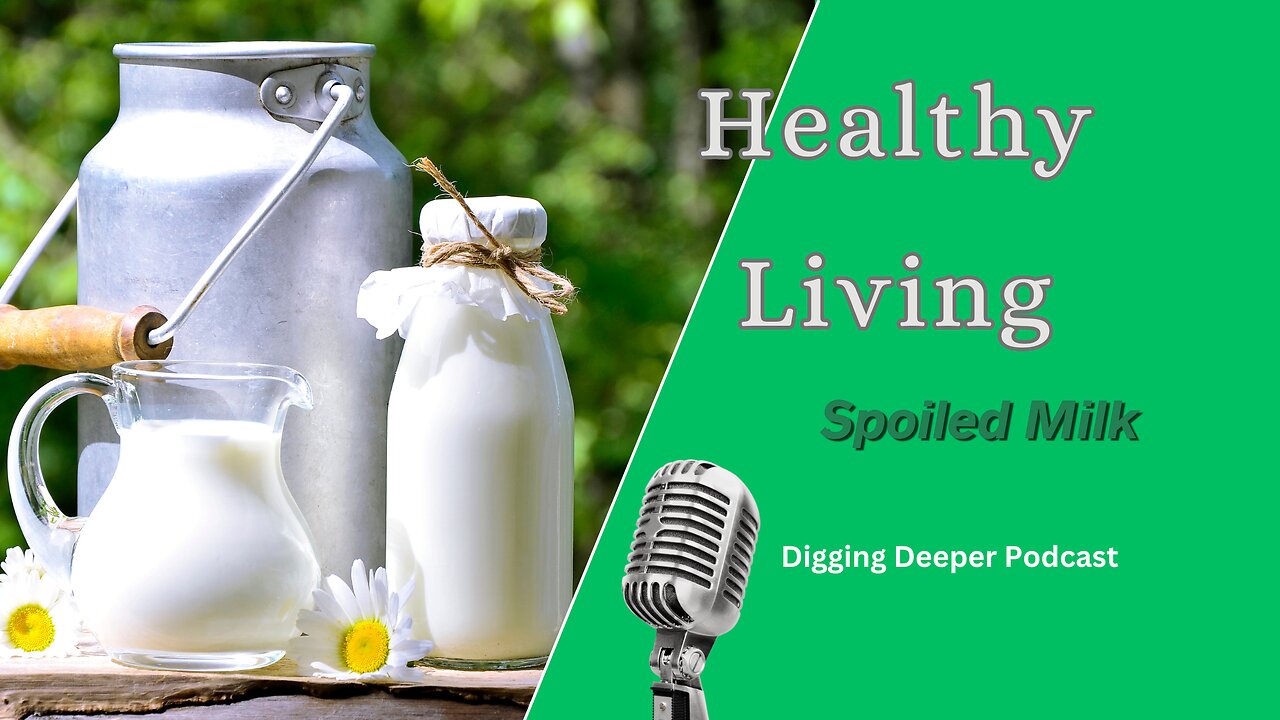Premium Only Content

Healthy Living; Spoiled Milk
Milk does a body good, right? Humans have been drinking animal milk for thousands of years and never had any problems. And yet these days, the natural milk right from the cow (or goat, etc.) is dangerous.
The reason milk has been deemed deadly is because of commercialization. In the big cities in the 1800’s, dairy cows would be fed the chaff of the grain used in alcohol production next door. This feed was lacking in any nutrients, so the cows became sickly and their rumen (stomachs) could not kill all the bad bacteria, which then ended up in their milk. The milking conditions were also horrible. Cleanliness was not a priority which caused diseases like e-coli to contaminate the milk. This was when milk got a bad rap as spreading diseases like tuberculosis and e-coli.
In 1856, Pasteur discovered that fermentation was caused by microbes, and that the results of that process – e.g. whether grape juice became wine or vinegar – depended on the microbe present. Later, he saved France’s wine industry from being taken over by the ‘bad’ vinegar microbe, and realized that heating up the wine to a specific temperature for a specific time would kill the microbe and preserve the wine. He patented the procedure and called it ‘pasteurization’.
Pasteurization was then used by the dairy industry in the late 1800s and around the turn of the century because tuberculosis was rampant and often spread through contaminated milk. Robert Koch discovered that tuberculosis was caused by a bacterium and infectious, and not – as widely believed – inheritable, in 1882.
The first law requiring the pasteurization of milk was passed in Chicago in 1908, and has since been the common practice in the US. The process protects the public from food-borne illnesses including salmonellosis, yersiniosis, E. coli-associated hemolytic-uremic syndrome (HUS), brucellosis, listeriosis, typhoid fever, Campylobacter enteritis, Q fever, and cryptosporidosis. It also extends the shelf life of the milk.
Sounds like a no brainer, right? So what’s wrong with pasturized milk?
Pasteurization is viewed by some as a blessing and by others as a curse. It is possible to find a great amount of detail on the Internet that supports each point of view. Pasteurization not only kills unwanted bacteria and other microbes in milk but also significantly alters the nutritional value and digestibility of the pasteurized milk itself.
Drink pasteurized milk at your own risk!
Not everyone responds to pasteurized milk in the same way. While it is harmful at some level to anyone who consumes it, its negative effects vary widely.
Here are 10 reasons to think twice before consuming pasteurized milk products.
Pasteurization is a process of heating raw milk to kill harmful bacteria, but only milk from a diseased animal or milk that has been handled in an unsanitary manner, will contain harmful bacteria.
During the pasteurization process milk is heated to a temperature that is harmful to the enzymes and other proteins that naturally occur in unheated raw milk. Pasteurized milk therefore contains denatured proteins.
Denatured proteins cannot be completely broken down in the human body. This many times results in lactose intolerance.
Partial breakdown of these denatured proteins results in undigested protein molecules which contribute to cellular inflammation and mucous formation. This increases waste products.
An increase in waste products in the bodily fluids contributes to overall toxicity and can overtax the lymphatic system affecting overall immune efficiency.
Pasteurized milk in the form of ice cream, cheese, yogurt, etc. will have the same negative effect as drinking the milk in liquid form.
The enzymes needed to break down lactose, the sugar found in milk, stops being produced in humans between the ages of two and five years old. To continue to drink pasturized milk past the age of five spells trouble to a person’s overall health.
Pasteurized milk contains an altered form of calcium that is very poorly absorbed by the human body. People who insist that milk should be consumed for its high calcium content are terribly misinformed.
The calcium found in pasteurized milk is of an extremely poor quality. It is the kind of calcium that readily forms kidney stones, gallstones and phleboliths (calcification in arteries and veins).
So what is the alternative?
Raw milk is fresh from the cow, but how do you ensure that it’s not contaminated? We like to say “Shake the hand that feeds you.” You not only help out the small business owner, but you develop a relationship with them and know first hand how they run their operation.
In many ways, raw milk is similar to breastmilk: both are completely natural, fresh, and unprocessed milks. They both contain a wide variety of essential nutrients, fats, proteins, anti-inflammatory and digestive enzymes, bioavailable vitamins, and minerals, all in a natural form which is most easily utilized by the body. In addition, raw milk facilitates production of lactase enzyme in the intestinal tract, allowing many people who are lactose intolerant to digest raw milk with no problems.
Main Findings
Large studies have found that raw milk consumption is associated with lower rates of:
asthma
allergies
eczema
ear infections
fevers
respiratory infections
Allergy protection ceases when raw milk is heated to 149 °F, which is the same temperature at which the whey proteins are denatured. It is likely that the raw whey proteins are responsible for raw milk’s beneficial effects on allergies, asthma, and inflammation.
Childhood consumption of raw milk correlates with higher pulmonary (lung) function and lower incidence of allergic diseases in adults.
Raw milk’s beneficial effects on asthma are partially mediated by regulatory T cells.
-
 31:38
31:38
Digging Deeper Original Podcasts
6 months agoThe Ugly Truth; No More Diddy Parties
2.72K -
 1:50:59
1:50:59
Steven Crowder
3 hours agoBREAKING: Shooter Caught & Shooting Eyewitness Joins to Discuss What He Saw
406K443 -
 LIVE
LIVE
Reidboyy
1 hour agoHow To Make $$$ in Delta Force Console Operations!
45 watching -
 LIVE
LIVE
The Mel K Show
2 hours agoMORNINGS WITH MEL K - Desperate Globalist Agenda Continues Unabated as Manufactured Chaos Abounds 9-12-25
1,019 watching -
 LIVE
LIVE
Sean Unpaved
59 minutes agoTNF Recap: Packers Roll, Commanders Crumble & NFL/CFB's Week 2-3 Predictions
68 watching -
 2:55:00
2:55:00
Benny Johnson
4 hours ago🚨Charlie Kirk's Killer CAUGHT: FBI Press Conference LIVE Right NOW | Trump Demands DEATH PENALTY
149K271 -
 DVR
DVR
Bannons War Room
6 months agoWarRoom Live
35.8M8.38K -
 35:53
35:53
Tudor Dixon
2 hours agoCharlie Kirk Assassination: Confronting Terrorism with Rob Chadwick | The Tudor Dixon Podcast
7.44K2 -
 1:01:02
1:01:02
VINCE
4 hours ago'WE GOT HIM' - Charlie's Killer In Custody | Episode 124 - 09/12/25
318K239 -
 LIVE
LIVE
LFA TV
13 hours agoKILLER CAUGHT LIVE PRESSER! - FRIDAY 9/12/25
5,143 watching